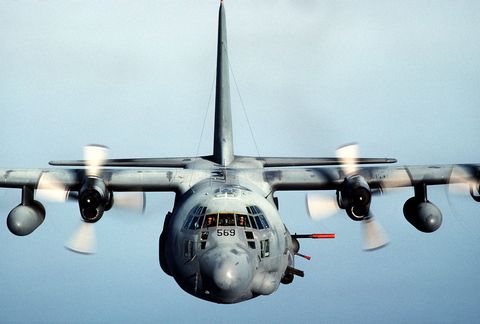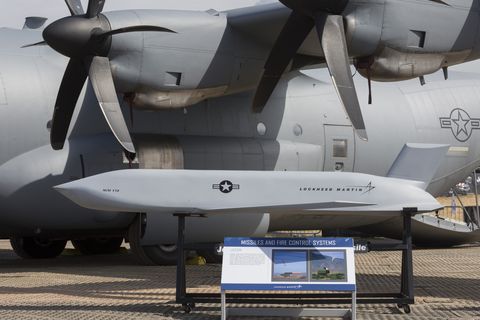
- The Air Force is proposing turning unarmed military cargo jets into temporary bombers.
- Cargo jets, with their large internal volume, could launch missiles from safe distances, far away from enemy forces.
- The Air Force has already successfully tested dropping simulated munitions from the back of airplanes.
The U.S. Air Force is looking at arming otherwise unarmed cargo planes, pressing them into service as makeshift bombers. The service believes future wars with adversaries like Russia or China will require plenty of aerial firepower and transport planes, loaded with pallets of cruise missiles, could provide an inexpensive solution.
According to Defense News, the Air Force thinks aircraft such as the C-130J Super Hercules and C-17 Globemaster III could become part-time missile trucks.
The unarmed aircraft typically shuttle troops and equipment, but in a pinch, would be equipped with “smart pallets” carrying long-range cruise missiles and other munitions.
The pallets would be capable of feeding position, navigation, and targeting data to their onboard missiles. Once dropped from the rear of the aircraft, the pallets would quickly release their missile cargoes, sending them downrange to their targets. The larger the aircraft, the more missiles it could carry.The missile truck concept pairs aircraft with large cargo boxes, of which the U.S. military has hundreds, with advanced missiles like the Joint Air to Surface Standoff Missile (JASSM). The latest version of JASSM, JASSM-XR, will have a range of 1,000 nautical miles—far enough for slow, lumbering, non-stealthy transports like the C-17 to launch dozens of missiles at enemy targets while staying out of missile and interceptor range.
Once a mission is over, the aircraft could be loaded with more smart pallets or go back to its traditional cargo carrier role.
The Air Force has been converting cargo planes into armed warbirds since the Vietnam War, when it added banks of Gatling guns to C-47 and C-130 transports. These gunships proved effective in providing close air support firepower and hunting Viet Cong forces traveling along the Ho Chi Minh trail.
The Air Force is still modifying transports for gunship duty, with the latest AC-130J mounting a 105-millimeter howitzer, a 30-millimeter autocannon, and soon a 60-kilowatt laser weapon.

Most armed transport conversions are permanent, with an unarmed transport aircraft transformed into a heavily armed gunship for good. In 2010, however, the U.S. Marine Corps introduced Harvest Hawk, a conversion kit for its KC-130 transport/tanker planes. Harvest Hawk allowed the Marines to launch Hellfire, Griffin, and Viper Strike air-to-surface missiles from a KC-130 against targets on the ground. A KC-130 equipped with Harvest Hawk can still perform aerial refueling and transport missions.
Ideally, the perfect choice for launching swarms of cruise missiles at an enemy is the upcoming B-21 Raider stealth bomber—the coolest plane we've never seen. A B-21 could penetrate enemy defenses, attack targets, and slip out of enemy territory, ideally all without being detected.
But at $621 million per aircraft, the B-21 is relatively expensive, and large numbers of the aircraft are a decade away. The Air Force has hundreds of transport planes that are paid for and ready to fly right now.

A C-130J Super Hercules and JASSM cruise missile pictured alongside one another at the Farnborough Air Show, 2018.
The Air Force expressed hesitation in the past in arming transport planes—after all, a future conflict will find them moving and resupplying their own far-flung forces worldwide. Recent tests at Dugway Proving Ground, however, seem to have changed the service’s opinion. The tests saw a MC-130J Combat Talon special operations transport successfully airdrop three pallets, each carrying a simulated load of long range cruise missiles.
The bomb truck concept, if successful, could greatly increase the number of cruise missiles available to U.S. forces at the start of a conflict. After their initial combat mission, the transports could quickly return to their traditional roles. If the concept gains traction, the bomb truck concept could give the Air Force a tremendous boost in firepower—all without buying a single new plane.



No comments:
Post a Comment